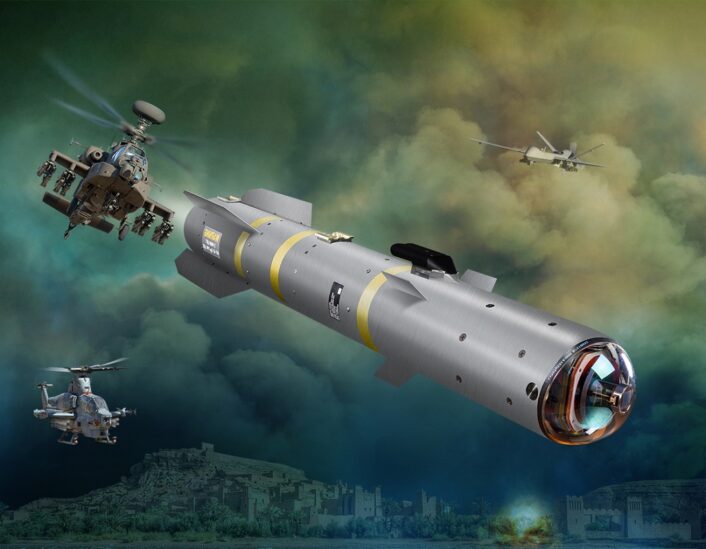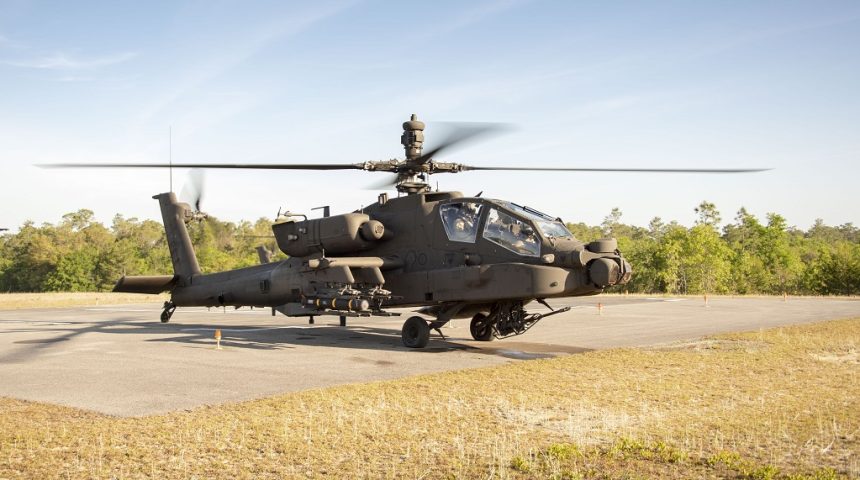The new JAGM missile is set to replace the AGM-114 Hellfire, BGM-71 TOW and AGM-65 Maverick.
After a lengthy and troubled development, the U.S. Army and the U.S. Marine Corps finally approved the AGM-179 Joint Air-to-Ground Missile (JAGM) for full-rate production on Aug. 30, 2022. The decision, initially expected last year, was delayed after the weapon failed to achieve desired lethal effects during testing, resulting in the Army and Marine Corps delaying the missile’s fielding to solve the problem.
The milestone also marks the successful completion of the operational testing of JAGM on the Army’s AH-64E Apache and the Marines’ AH-1Z Viper helicopters. JAGM replaces the legacy AGM-114 Hellfire missile used across the services, but it has been designed to also replace the BGM-71 TOW and AGM-65 Maverick missiles.
JAGM already entered into Low-Rate Initial Production in June 2018. Lockheed Martin produced JAGM in limited quantities to establish a production base and support the operational testing and evaluation of the new weapon. The company delivered the 1,000th JAGM to the Army in February 2022.
JAGM combines a dual-mode seeker and guidance system with the combat-proven AGM-114R Hellfire missile bus to take precision engagement to the next level. The missile has been designed to be backward compatible with the M299 launcher and, with appropriate integration upgrades, with all platforms (air, ground and maritime) that currently are capable of employing Hellfire missiles.
The dual-mode sensor offers enhanced performance on the battlefield, combining Semi-Active Laser (SAL) and millimeter wave (MMW) radar sensors and providing precision strike and fire-and-forget capability against stationary and moving land and maritime and even airborne targets. This seeker enables JAGM users to strike multiple targets, near simultaneously, with more precision in adverse weather and obscured battlefield conditions which increases user survivability and effectiveness.
Interestingly, the seeker’s transparent dome has been blurred in every photo released by the Army and Marines so far. In some cases, the markings on the missile have been blurred too. In either case, JAGM and Hellfire look almost indistinguishable in the photos, considering that JAGM shares the same motor and warhead of the AGM-114R and the main difference is the seeker and guidance section in the front.
The Army experienced several failures during live-fire testing of an early engineering and manufacturing development version from an AH-64E Apache prior to 2018, including two missiles missing their target. The report stated that one struck the ground “well outside the burst radius of the warhead” and another struck “near the bottom of the vehicle track and road wheels”. During a major test event where 18 missiles were launched from an AH-64E Apache attack helicopter, one of the four launches with a live warhead also failed to detonate. The Army said it was able to resolve those problems in subsequent testing and evaluation.

The Marines also struggled with JAGM on the AH-1Z Viper during an initial operational test and evaluation at Fort Hood, Texas, and Eglin Air Force Base, Florida, in mid-2019. Two missiles were fired, both of which did not hit boat targets at the center of the vessel, but rather striking more towards the back. Again, the problems were solved in subsequent rounds of testing.
In March 2019, JAGM achieved the Initial Operating Capability for the U.S. Army’s AH-64E Apache helicopters. Immediately after the IOC, operational pilots fired missiles in all JAGM engagement modes against stationary and moving, maritime and land targets in daytime conditions during Initial Operational Test & Evaluation at Fort Hood, Texas, and Eglin AFB, Florida. Some of the armored targets were obscured or covered by countermeasures like smoke, radar reflectors and/or camouflage netting, with JAGM demonstrating high lethality even in presence of the countermeasures.
The live fire testing included shots against an up-armored T-72, a BMP infantry fighting vehicle, personnel in the open, and behind brick over block and adobe walls, according to the unclassified Director Operational Test and Evaluation report. The missile demonstrated improved lethality against those targets by using a new delayed fusing capability, delaying warhead detonation until after missile penetration for maximum damage.
JAGM has not been tested yet in an active electronic warfare environment or against threats equipped with Active Protection Systems, but the Army intends to evaluate this in future testing to check if these emerging threat capabilities can limit JAGM performance. DOT&E is also recommending the Army to conduct missile flight testing in the Arctic to assess performance while in presence of extreme cold temperatures.
The US #Marine Corps has declared Initial Operating Capability #IOC for the AGM-179A #JAGM Joint Air-to-Ground #missile to be used on AH-1Z Viper attack helicopters. The weapon is an upgrade over Hellfire, TOW and Maverick missiles https://t.co/ORutyMy1ND pic.twitter.com/VOGeY5abLz
— Chris Cavas (@CavasShips) March 15, 2022
In March 2022, JAGM also achieved the IOC on the AH-1Z Viper attack helicopter, following the latest test campaign where AH-1Z pilots employed JAGM off the coast of Florida in November 2021 and conducted land-based testing in Arizona in December 2021. The Marines conducted multiple live-fire test missions against realistic operational threats at sea, successfully firing at moving target boats with a range of 7km away and demonstrating the helicopter’s maritime targeting capability.
The plan is to ultimately integrate JAGM onto helicopters and unmanned aircraft, like the MQ-1C Gray Eagle, as well as on air defense systems like the Mobile Short-Range Air Defense System, or M-SHORAD, that the Army rapidly fielded to its formations in European last year. In fact, Rita Flaherty, Lockheed Martin’s vice president for strategy and business operations within its Missiles and Fire Control sector, first talked about this M-SHORAD concept to reporters at Eurosatory 2022 in Paris.
The Hellfire missile is already available for the M-SHORAD Stryker-based system that the U.S. Army developed. The service generated the requirement to build the system in February 2018 and, in just 19 months, the first prototypes were delivered for testing. Given the compatibility of JAGM with the AGM-114 launchers, it is expected that the new missile can be quickly integrated on the M-SHORAD.
Lockheed Martin is also investing in future JAGM improvements, including a JAGM-Medium Range variant with range increased from 8 km to 16 km without impacting the missile’s length or diameter. The company is also continuing to work with the U.S. Air Force on a fixed-wing launch capability as AGM-65 Maverick replacement, said Flaherty.
Originally known as JAGM-F or JAGM Increment 3, the fixed-wing compatible missile is expected to have a range of 16 km (which is less than the Maverick’s range in excess of 22 km) alongside other redesigns for carriage and launch from fast jets. Candidate platforms to receive the JAGM were said to include the AV-8B Harrier and F-35B Lightning II, while some carriage testing was performed on the F/A-18 Super Hornet.
#JAGM-F #LRASM #JASSM #Spice1000 pic.twitter.com/UkUmQNne6O
— Defence Decode® (@DefenceDecode) May 20, 2021
The integration on the F-35 was expected after the Block 4 upgrade and was said to include also the capability to launch the missile from the weapon bays. A possible configuration shown few years ago involved a four-weapon rack similar to the BRU-61 used for the GBU-39 Small Diameter Bomb or the rack used for the British SPEAR 3 (Selective Precision Effects at Range Capability 3) air-to-surface missile (which can be similarly launched from the weapon bays).









